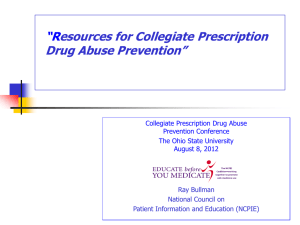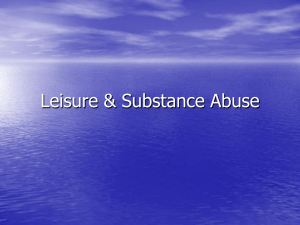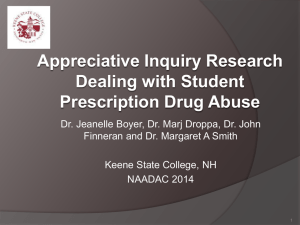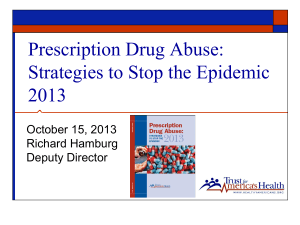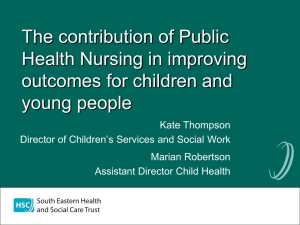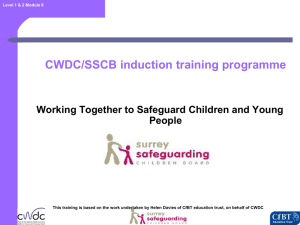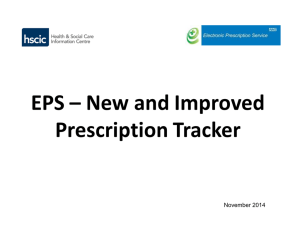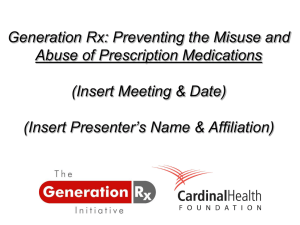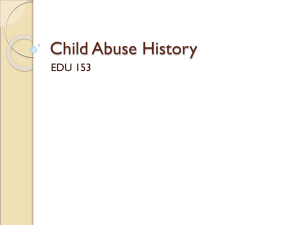Take-Aways * From the HBCU Campus Dialogue
advertisement
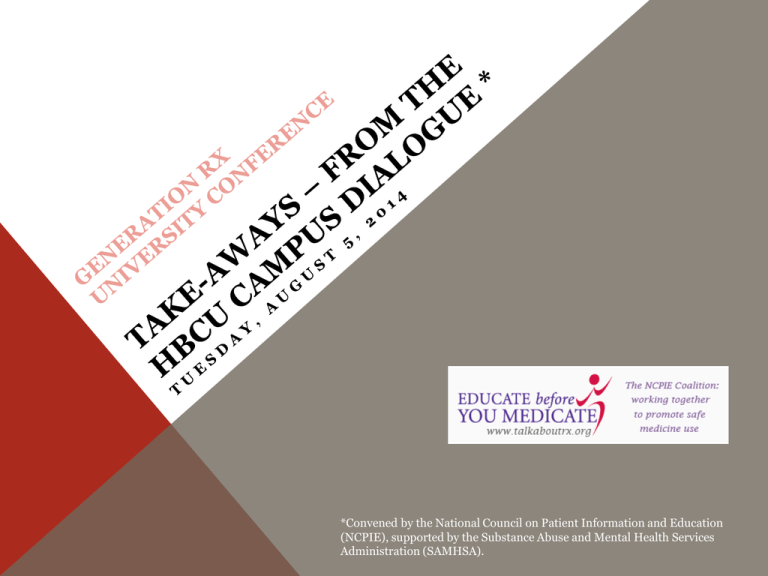
*Convened by the National Council on Patient Information and Education (NCPIE), supported by the Substance Abuse and Mental Health Services Administration (SAMHSA). YOUR PRESENTERS W. Ray Bullman, Executive Vice-President, National Council on Patient Information and Education Ayana Evans, Howard University Undergraduate Student Ashley Washington, Howard University Doctor of Pharmacy Candidate HBCU CAMPUS DIALOGUE ON PRESCRIPTION DRUG ABUSE, TREATMENT & RECOVERY GOAL Two-day meeting to begin understanding how prescription drug abuse impacts students attending HBCUs. WHY HBCUs? A research agenda that is screaming for attention. Little information about the incidence of prescription drug abuse among communities of color and most particularly among students from HBCUs. Issue is hidden from view. HBCU CAMPUS DIALOGUE Over 40 attendees converged on the Howard University Campus – Friday-Saturday, March 28-29, 2014, representing Morgan State University, Baltimore, MD Trinity University, Washington, DC University of DC, Washington, DC University of MD Eastern Shore, Princes Anne, MD University of MD College Park, MD Substance Abuse and Mental Health Administration Area non-profits ABOUT HISTORICALLY BLACK COLLEGES AND UNIVERSITIES (HBCU) HBCU’s – a long historical legacy, founded after the Civil War. Located mostly in the southeastern portion of the US. Have graduated individuals such as Martin Luther King, W.E.B. DuBois and Booker T. Washington – to name a few. Today there are 100 HBCUs – representing just 3% of institutions of higher learning. Approximately 9% of all African American college students attend HBCUs. HBCUs graduate nearly 20% percent of African Americans who earn undergraduate degrees and more than 50% of African American professionals and public school teachers. While HBCUs were created to support African American students , today they attract a significant percentage of non-African American students – Asian, Hispanic,-Latino, International and Caucasian. WHAT WE KNOW – THE BIG PICTURE …nonmedical use of any prescription-type pain relievers, tranquilizers, stimulants or sedatives. According to the 2012 National Survey on Drug Use and Health (NSDUH): There were about 2.4 million people, aged 12 or older who used psychotherapeutics nonmedically for the first time within the past year, which averages to about 6,700 initiates per day. The average age at first nonmedical use of any psychotherapeutics among recent people, aged 12 to 49 was 22.9 years – implying that we need to reach young people before they start using. The rate of current nonmedical use of psychotherapeutic drugs among young adults aged 18-25 was 5.3% - similar to the rates in 2010 and 2011. WHAT WE KNOW – SUBSTANCE ABUSE AMONG PEOPLE-OF-COLOR Points to… Substance use rates are generally lower among Black adolescents than national rates for adolescents. HOWEVER, the recent increases in marijuana use and in the nonmedical use of prescription-type drugs among black adolescents highlight the need for treatment programs and prevention strategies that target Black adolescents. NSDUH Report: Substance Use among Black Adolescents; October 4, 2011 A need for more information and education among Black, college-aged young people. AGE OF FIRST-USE Points to… Data indicate that people of color start using drugs before the age of 25. The NSDUH Report: Substance Use among Black Adolescents; October 4, 2011, http://www.samhsa.gov/data/2k11/WEB_SR_ 004/WEB_SR_004.htm The need for efforts to prevent, delay, or reduce drug use particularly strategies that target the critical period of late adolescence, having long-term implications for improvements in behavioral and physical health, education, and employment outcomes among this population. RX ABUSE AMONG BLACK ADOLESCENTS Points to… Nonmedical use of prescription type drugs among Black adolescents was relatively stable from 2002 to 2007. After a drop to 2.1% in 2008, the rate of nonmedical use of prescription drugs among black adolescents rose to 3.5 % in 2009, the difference between the rate in 2009 and 2010 was not statistically significant. The NSDUH Report: Substance Use among Black Adolescents; October 4, 2011, http://www.samhsa.gov/data/2k11/WEB_S R_004/WEB_SR_004.htm The fact that prescription drug abuse among Black adolescents rose in 2009 and has remained stable indicates the need to raise awareness about this issue and ultimately to bring it into the light. HBCU CAMPUS DIALOGUE OBJECTIVE Participants were tasked with crafting prevention and intervention paradigms that could resonate within a university environment. FORMAT Day 1: Faculty and Staff Day 2: Undergraduate and Graduate Students DIALOGUE FINDINGS CYCLE OF INFLUENCE TRANSFORMING THE CYCLE OF INFLUENCE INTO HOPE “We need to push for transparency so we can work on mutual interests. There’s a lack of organization [about prescription drug abuse and related issues] on campus – is there some way to come together and address these challenges?” Day Two, Student Participant HBCU Campus Dialogue on Prescription Drug Abuse 1. Identify system challenges. 2. Shift the viewpoint. 3. Articulate provocative possibilities – what would change look like in five years or ten years? 4. Identify strategies to get there. 5. Create prototypes at the micro level. 6. Exploit conditions to viralize change. AGENTS FOR CHANGE NORMS… SELECTED ACTIONS CHALLENGES No meaningful responses to address this problem other than punitive actions. RAs, who are ideally positioned to help students with the transition to college, aren’t prepared. Freshmen orientation is essentially useless for addressing Rx abuse issues. No one knows how to talk about their problems until the problems reach crisis proportions. Include prescription drug abuse prevention as part of a university’s course offerings. Create freshmen orientation programs that are meaningful and engaging. Engage the community’s cultural brokers as spokespersons. Reconnect with tradition. Dedicate money for research: In addition to spending funds on testing medications, expand the research to include testing alternative medicines. INSTITUTIONAL BIAS CHALLENGES Faculty and staff put on blinders regarding the stress that students experience. There is a lot of red tape and bureaucracy. SELECTED ACTIONS The university’s response to failing students is too punitive. Not enough faculty support in helping students achieve. Institutional bias can leave students feeling angry and isolated. Set up dialogues between faculty/staff and students that open the lines of communication. Create peer support for incoming freshmen. Support collaboration across the university to address student academic failure, and develop strategies that support student success. Create and/or strengthen the protocols that track failing students. Craft holistic, sensitive responses to address academic failure. TRANSITIONAL STRESS SELECTED ACTIONS CHALLENGES Monthly life seminars for ALL students. No internal resources to cope Senior seminar that addresses transition into adulthood. with the changes they’re experiencing. Ongoing and comprehensive RA training. Lack family support. Mentoring opportunities. Lack of confidentiality on campus. For students, Freshmen Orientations isn’t enough. Lack of connection between professors and students. Online de-stressor chat rooms and groups Campus-wide “unplugged day.” Offer a wide variety of exam-taking options. AVAILABILITY OR OVERPRESCRIBING CHALLENGES SELECTED ACTIONS Doctors are not getting to know their patients, and are prescribing meds rather than pursuing alternative approaches. Medicines are too easily accessible. Abuse of Adderall is a problem. Students don’t see their medicinetaking behaviors as “Abuse.” Don’t have a comprehensive understanding of how students are misusing and abusing meds. Support educating healthcare professionals about the problems associated with overprescribing. Create a two-minute video that accurately depicts the realities of overprescribing, and require its viewing! Encourage the development of student, staff and faculty seminars on Adderall abuse: LACK OF RESOURCES SELECTED ACTIONS CHALLENGES Lack of awareness about on- and off-campus resources. Absence of treatment availability. Students aren’t engaged in creating solutions. Some students will never seek help – how can we reach these students? Consistent and regular promotion of resources, using positive messaging. Counseling center as a go-to alternative. Support that’s available at “all hours.” An app that notifies students of alcoholfree alternatives, and monitors stress levels and signs of depression. Parents and guardians dialogues. Universal screening for all students Designated safe havens. Health and Wellness Committee that solidly supported by Campus administrators. SOCIAL MEDIA CHALLENGES Social media is being used to promote drug-taking activities and behaviors, sending the wrong message – that drug taking is the norm. What we see on TV and in the movies condones drug use. SELECTED ACTIONS The administration is powerless to stop these messages from being broadcast over the airwaves. Focus groups or informal discussions with students to confirm the methods and messaging they are receiving and sending about alcohol and other drugs. Acknowledge the role that media plays in influencing drug and alcohol abuse. Build opportunities where students and university staff and faculty can communicate with each other. WHY WE CARE… 1. How can we do a better job of creating connections between prescription drug abuse and the risk and protective factors that influence/protect students from abusing these medicines? 2. What parallels can we draw? Correlating issues and/or populations? 3. How can YOU bring some of these issues and recommendations to light on your campus? LET’S TALK ABOUT IT! THANKS FOR PARTICIPATING To learn more…. Ray Bullman National Council on Patient Information and Education 301.340.3940 bullman@ncpie.org www.talkaboutrx.org
